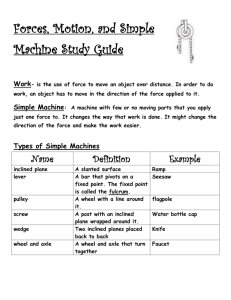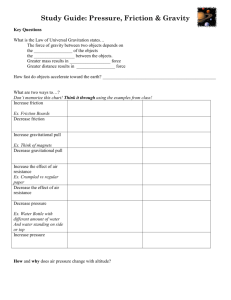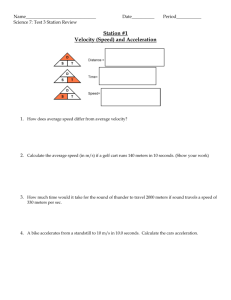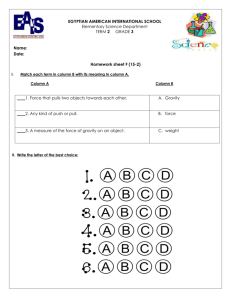Inclined Plane - Cobb Learning
advertisement
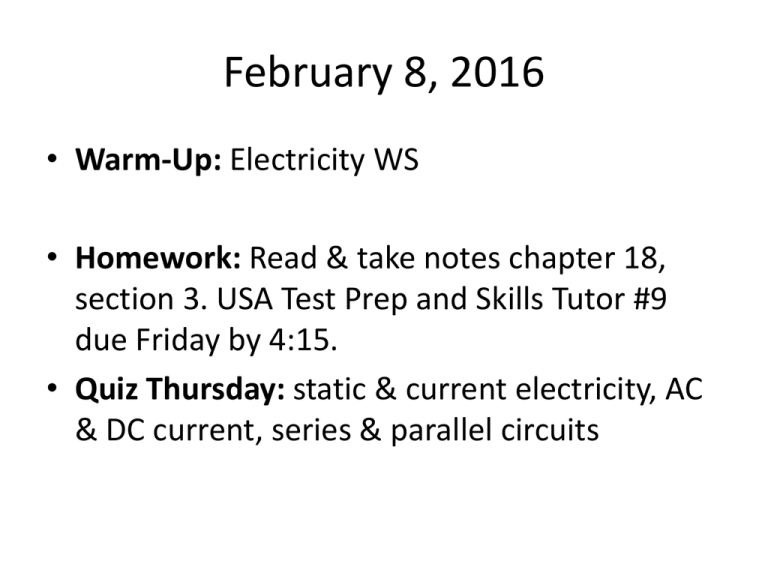
February 8, 2016 • Warm-Up: Electricity WS • Homework: Read & take notes chapter 18, section 3. USA Test Prep and Skills Tutor #9 due Friday by 4:15. • Quiz Thursday: static & current electricity, AC & DC current, series & parallel circuits February 8, 2016 • Warm Up: start Simple Machines WS • Homework: USA Test Prep and Skills Tutor #9 due by Friday @4:15 • Test Wednesday: Chapters 5, 6, & 8 SPS8. Students will determine relationships among force, mass, and motion. • a. Calculate velocity and acceleration. – Know the difference – Know the units – Know how to solve the problems – Know how to interpret the graphs Question 1 • • • • • An object accelerates if its A. Speed remains constant B. Direction changes C. Mass remains constant D. Motion can be plotted on a graph Question 1 • • • • • An object accelerates if its A. Speed remains constant B. Direction changes C. Mass remains constant D. Motion can be plotted on a graph Question 2 • Which kind of forces are exerted on an object if there is a net force of zero? • A. Unbalanced • B. Kinetic friction • C. Gravity • D. Balanced Question 2 • Which kind of forces are exerted on an object if there is a net force of zero? • A. Unbalanced • B. Kinetic friction • C. Gravity • D. Balanced SPS8. Students will determine relationships among force, mass, and motion. • b. Apply Newton’s three laws to everyday situations by explaining the following: 1) Inertia 2) Relationship between force, mass and acceleration 3) Equal and opposite forces – Know real world examples – If given a situation, be able to predict what will happen Question 3 • Which two forces operate to keep a moon in orbit around a planet? • A. Inertia and gravity • B. Inertia and friction • C. Friction and gravity • D. Distance and gravity Question 3 • Which two forces operate to keep a moon in orbit around a planet? • A. Inertia and gravity • B. Inertia and friction • C. Friction and gravity • D. Distance and gravity Question 4 • A baby pushes on a large chair. What is the reaction force? • A. Friction pushes on the chair • B. Friction pushes on the baby • C. The chair pushes on the baby • D. The chair pushes on the floor Question 4 • A baby pushes on a large chair. What is the reaction force? • A. Friction pushes on the chair • B. Friction pushes on the baby • C. The chair pushes on the baby • D. The chair pushes on the floor Question 5 • A student kicks a soccer ball across a field. The ball rolls across the field and stops. What causes the ball to stop? • A. Gravity acts on it • B. Its own inertia stops it • C. Friction acts on it • D. Balanced forces act on it Question 5 • A student kicks a soccer ball across a field. The ball rolls across the field and stops. What causes the ball to stop? • A. Gravity acts on it • B. Its own inertia stops it • C. Friction acts on it • D. Balanced forces act on it SPS8. Students will determine relationships among force, mass, and motion. • c. Relate falling objects to gravitational force – Understand how objects accelerate due to gravity – Understand that the gravitational attraction between two objects depends on MASS and DISTANCE Question 6 • Suppose you roll a basketball and a baseball toward each other. How does this affect the force they exert on each other? • A. It increases • B. It decreases • C. It stays the same • D. It disappears Question 6 • Suppose you roll a basketball and a baseball toward each other. How does this affect the force they exert on each other? • A. It increases • B. It decreases • C. It stays the same • D. It disappears Question 7 • Which pair of objects will have the LEAST gravitational attraction? • A. Two cinder blocks 6 cm apart • B. Two marbles 12 cm apart • C. A cinder block and a marble 6 cm apart • D. A cinder block and a marble 12 cm apart Question 7 • Which pair of objects will have the LEAST gravitational attraction? • A. Two cinder blocks 6 cm apart • B. Two marbles 12 cm apart • C. A cinder block and a marble 6 cm apart • D. A cinder block and a marble 12 cm apart • Gravitational attraction depends on mass and distance SPS8. Students will determine relationships among force, mass, and motion. • d. Explain the difference in mass and weight. – Know that weight changes if gravity changes, but mass does not Question 8 • Which statement is correct? • A. Weight is the amount of material in an object • B. Mass is the physical dimensions of an object • C. Weight is the gravitational pull on an object • D. Mass is the gravitational pull on an object Question 8 • Which statement is correct? • A. Weight is the amount of material in an object • B. Mass is the physical dimensions of an object • C. Weight is the gravitational pull on an object • D. Mass is the gravitational pull on an object Question 9 • Your weight on Mars is only about 1/3 your weight on Earth. Which reason BEST explains this? • A. Mars is more massive than Earth • B. Mars has a smaller force of gravity than Earth • C. Mars has a greater force of gravity than Earth • D. An object on Mars has less mass than the same object on Earth Question 9 • Your weight on Mars is only about 1/3 your weight on Earth. Which reason BEST explains this? • A. Mars is more massive than Earth • B. Mars has a smaller force of gravity than Earth • C. Mars has a greater force of gravity than Earth • D. An object on Mars has less mass than the same object on Earth SPS8. Students will determine relationships among force, mass, and motion. • e. Calculate amounts of work and mechanical advantage using simple machines. – Know the six simple machines – Understand how they help us do work – Know how to calculate work and MA if given the basic versions of the formula – Know units of work, force, and distance Six Simple Machines • Inclined Plane • Wedge • Screw • Lever • Pulley • Wheel & Axle Mechanical Advantage Inclined Plane • Reduces force, but increases distance • The mechanical advantage of an inclined plane is length divided by height. • Wedges and screws are types of inclined planes. MA = L/H Wedge • A wedge generates outward forces • A wedge is a type of inclined plane. Its mechanical advantage is its length divided by its greatest thickness. Screw • A screw is an inclined plane wrapped around a cylinder • Uses a small force over a longer distance • The closer the threads, the lower the force required Levers – Three Classes • Can change direction & size of force • In a first-class lever, the fulcrum is between the force and the load. • In a second-class lever, the load is between the force and the fulcrum. • In a third-class lever, the force is between the fulcrum and the load. First Class Lever Change direction & maybe force Second Class Lever Change force, but not direction Third Class Lever Don’t change direction, output < input Pulleys • Change direction and may change input force • Types of pulleys include fixed pulleys, movable pulleys, and block and tackles. Wheel and Axle • The mechanical advantage of a wheel and axle is the radius of the wheel divided by the radius of the axle. Compound Machines • Compound machines consist of two or more simple machines. • Compound machines have low mechanical efficiencies because they have more moving parts and therefore more friction to overcome. Question 1 • Which of the following simple machines is a wedge? • A. Wheelbarrow • B. Doorknob • C. Ax • D. Truck ramp Answer • Which of the following simple machines is an example of a wedge? • A. Wheelbarrow • B. Doorknob • C. Ax • D. Truck ramp Question 2 • • • • • What is the pivot point of a lever called? A. Load B. Fulcrum C. Wedge D. Effort Answer • • • • • What is the pivot point of a lever called? A. Load B. Fulcrum C. Wedge D. Effort Question 3 • A student pushes on a lever with a force of 40N. The 150N load does not move. Which of the following is true? • A. Input force is 40 N and work done is 0 J. • B. Input force is 40 N and work done is 600 J. • C. Output force is 40 N and work done is 150J. • D. Output force is 150N and work done is 40J. Answer • A student pushes on a lever with a force of 40N. The 150N load does not move. Which of the following is true? • A. Input force is 40 N and work done is 0 J. • B. Input force is 40 N and work done is 600 J. • C. Output force is 40 N and work done is 150J. • D. Output force is 150N and work done is 40J.

